A New Look at Trends in Colorado’s Marijuana Market

AP Photo/David Zalubowski n this Wednesday, Oct. 11, 2017, file photograph, a worker waters marijuana plants at the Colorado Harvest Company in Denver.
The state provided a detailed update on the industry, which is clearing $1 billion in sales annually.
Colorado’s legal pot market is overtaking black market sales, a comprehensive new study released Thursday by the state’s Department of Revenue suggests.
The report relies on new analytical methods to provide one of the clearest pictures to date about trends in Colorado’s marijuana market, according to the state. Recreational and medical marijuana sales together totaled about $1.5 billion in Colorado in 2017.
The state’s total operating budget for fiscal year 2017-2018 was about $28.8 billion.
“The results of the study indicate that the illicit market for resident and visitor marijuana has been largely, if not entirely, absorbed into the legal market,” the report says.
Mike Hartman, executive director of the state’s Department of Revenue said in a statement that the study gave him comfort “that the licensed, regulated commercial marketplace is working well.”
The report shows pot consumption plateaued in Colorado over the past two years, after rising briskly between 2014 and 2016. Legalized adult recreational sales began in 2014.
Colorado residents consumed around 189 metric tons of marijuana in 2017, the report says. Visitors consumed 19 metric tons. Consumption figures are based on demographics, responses to surveys, and other research, and must be estimated, the report explains.
In addition to consumption estimates, the study authors calculated demand for marijuana based on state inventory tracking data.
They estimate that total marijuana demand in the state was 301 metric tons of “marijuana flower equivalent” last year. The state says the methodology behind the “flower equivalent” measure is first-of-its-kind and allows for more accurate comparisons of supply, demand, potency and pricing across different kinds of marijuana products.
The report notes that “edibles,” such as cookies and brownies, make up an increasing share of regulated marijuana sales in the state, as do “concentrates,” which include oils that can be consumed using vaping devices.
While overall marijuana sales increased by about 51 percent between 2015 and 2017, concentrate sales were up 114 percent and edible sales rose by about 67 percent. Edibles made up 13 percent of the overall recreational market, but nearly 25 percent in tourist areas.
Across the board, prices are also down.
From 2014 to 2017 the price for marijuana in flower form, in the recreational market, fell from $14.05 to $5.34 per gram weighted average. Per gram prices for concentrate products fell from $41.43 to $21.57. Edible prices have been steady at about $18 per 100 milligram package.
The report also says the amount of marijuana getting seized or destroyed, or that does not meet quality standards, has decreased, indicating improved regulatory compliance in the industry.
A full copy of the study, Market Size and Demand for Marijuana in Colorado, can be found here.
Bill Lucia is a Senior Reporter for Government Executive's Route Fifty and is based in Washington, D.C.
NEXT STORY: Federal Disaster Recovery Efforts Are 'Not Sustainable,' Report Says






